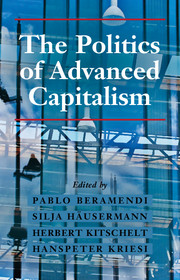Book contents
- Frontmatter
- Contents
- List of Figures
- List of Tables
- List of Contributors
- Preface
- 1 Introduction: The Politics of Advanced Capitalism
- PART I STRUCTURAL TRANSFORMATIONS
- 2 Prosperity and the Evolving Structure of Advanced Economies
- 3 The Origins of Dualism
- 4 Occupational Structure and Labor Market Change in Western Europe since 1990
- 5 Globalization, Labor Market Risks, and Class Cleavages Rafaela Dancygier and Stefanie Walter
- 6 The Return of the Family
- Part II Politics
- Part III Policies
- Part IV Outcomes
- Reference
- Index
6 - The Return of the Family
from PART I - STRUCTURAL TRANSFORMATIONS
Published online by Cambridge University Press: 05 May 2015
- Frontmatter
- Contents
- List of Figures
- List of Tables
- List of Contributors
- Preface
- 1 Introduction: The Politics of Advanced Capitalism
- PART I STRUCTURAL TRANSFORMATIONS
- 2 Prosperity and the Evolving Structure of Advanced Economies
- 3 The Origins of Dualism
- 4 Occupational Structure and Labor Market Change in Western Europe since 1990
- 5 Globalization, Labor Market Risks, and Class Cleavages Rafaela Dancygier and Stefanie Walter
- 6 The Return of the Family
- Part II Politics
- Part III Policies
- Part IV Outcomes
- Reference
- Index
Summary
Where is the family heading? The dominant view in popular debate and scientific research alike is that it is an eroding and perhaps even endangered species. The “ever-less family” scenario emerges from adherents of both Gary Becker's neoclassical economic model and theories of postmodernity. Both predict a continuous decline in marriage, more singlehood, and less binding partnerships through cohabitation or trendy “living apart together” arrangements. This, in turn, implies rising partnership instability, divorce, and repartnering. And we are said to face a long-term low fertility scenario as a growing proportion of citizens remain childless or desire fewer children.
These similar predictions emerge from diametrically opposed arguments. The Becker framework would stress the declining returns to marriage and the rising opportunity costs of motherhood that are associated with women's embrace of serious lifelong career ambitions (Becker 1960, 1981). The postmodernists see the “less family” scenario as being driven by new values that favor individualism and self-realization over long-term commitments (Lesthaeghe 1995, 1998).
I shall present an alternative interpretation of ongoing trends. The essence of my argument is that the process of family decay we have observed over the past half-century is transitory, not permanent. In my framework, the epoch of “less family” represents an unstable equilibrium. This implies, first, the absence of any strong, let alone hegemonic, normative coherence, and this is why it will fail to reproduce itself endogenously. Second, under such conditions family outcomes are likely to be Pareto suboptimal, exhibiting not only inefficiency but also inequities.
Rising family instability emerged in response to the decaying old normative order (equilibrium), premised on the male breadwinner-cum-housewife arrangement. This, in turn, was of course spurred by the revolution of women's roles. My core thesis is that a realignment of gender relations is a fundamental prerequisite for any new viable and stable family equilibrium to emerge.
- Type
- Chapter
- Information
- The Politics of Advanced Capitalism , pp. 157 - 176Publisher: Cambridge University PressPrint publication year: 2015
- 6
- Cited by

